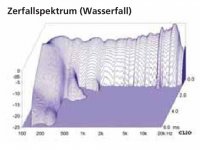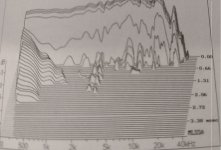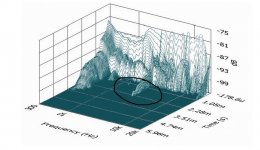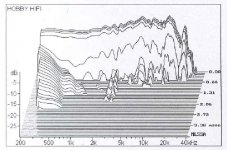I am evaluating the 10F 8414 for my speaker build, so I gather four third-party measurements of this driver and compare them. Those measurements are Klang+Ton 5/2013, HobbyHifi 3/2015 and Voice Coil December 2013 (available on AudioXpress Test Bench - Scan-Speak 10F/8414G10 Small 3.5” Full-Range Woofer | audioXpress ) and Erin's measurement ( Scanspeak 10F/8414G10 Discovery 4 inch Fullrange )
The frequency response, Impedance curve and distortion plot of the first three measurements is very similar. But the CSD plot is a bit different. Hobby Hifi & Voice Coil measurements show a resonance at 2-3 kHz up to 2ms, while this resonance is absent on the measurement on K+T.



Another problem is when comparing the THD plot of first three measurements with Erin's measurement. On the first three tests, the THD has a small bump at 1-2 kHz, ranging from 0.5-0.7% at 90dB SPL (on Hobby Hifi) to 1.25% at 95 dB SPL (on K+T and Voice Coil). On Erin's measurement, the THD is below 0.3% at 96 dB and even smaller at 90dBSPL.
I think all of them use IEC baffle to test, but their results are somewhat different. As a novice in speaker measurement, I don't know why it happens and which measurement I can trust. I am very grateful if experience people can help me explain it.
The frequency response, Impedance curve and distortion plot of the first three measurements is very similar. But the CSD plot is a bit different. Hobby Hifi & Voice Coil measurements show a resonance at 2-3 kHz up to 2ms, while this resonance is absent on the measurement on K+T.



Another problem is when comparing the THD plot of first three measurements with Erin's measurement. On the first three tests, the THD has a small bump at 1-2 kHz, ranging from 0.5-0.7% at 90dB SPL (on Hobby Hifi) to 1.25% at 95 dB SPL (on K+T and Voice Coil). On Erin's measurement, the THD is below 0.3% at 96 dB and even smaller at 90dBSPL.
I think all of them use IEC baffle to test, but their results are somewhat different. As a novice in speaker measurement, I don't know why it happens and which measurement I can trust. I am very grateful if experience people can help me explain it.
CSD plots have many variables that influence what you see in them. 2 of these plots have a rather short rise time, which shows the frequency response as a sort of cliff. (cutting it short)
The graph from K&T, that is more rounded in shape has a longer rise time which shows the data as if it were taken a little later in time. Basically hiding that early view.

The Hobby HiFi plot...
If one were to EQ these bumps around ~2K flat, that resonance would likely disappear. You can see it in the Frequency response as well. But it's there in the driver. I won't comment on what's causing it but at some point a wide band driver changes it's behavior from piston to more of a controlled break up to be able to play up high. Basically the higher it goes in frequency the part of the cone that plays the frequency changes (gets smaller) due to flex in the cone. The 10F does a remarkable job of creating a flat, though slightly rising response.
There is another set of measurements from Troels here. (scroll down)
About the distortion, that's a bit hard to say. Erin's measurements are newer (more recent than the others) and chances are the drivers have gotten an update somewhere in their life cycle. I see the frame thickness as 4 mm in the test descriptions but if I measure the 2 I have here I see a 3 mm thickness. Only an minor change, but it makes me think what else has been changed as well.
Without confirmation by other recent measurements it is hard to say which one is more right. Too bad Erin's measurements were taken with something loose on the baffle (at 400 Hz). I'm hoping Erin's measurements show an actual improved driver, as I have a lot of them coming my way to replace the rather excellent measuring TC9 in my arrays.(*)
Overall for such a small driver it is exemplary behavior with rising second order distortion but very well behaved third order distortion over much of it's bandwidth. A good driver for a fast with a woofer below it to handle the low notes. Or as Voice Coil Magazine put it: a great driver for line source applications. 😀
(*) The TC9's were doing an excellent job, but due to storage in a humid environment a couple of them failed on me within a short time span. Right where the lead wire connects to the voice coil, as it turns out the glue doesn't do a good job protecting the connection from the elements. As my drivers are 10 years old, chances are it may have been changed in recent years, but i could not get confirmation of that from Tymphany.
I've been told that Scan Speak has changed the glue they use after similar incidents with older drivers. Originally the TC9 was designed by Scan Speak and sold under the Vifa brand name (nowadays as Tymphany Peerless).
The graph from K&T, that is more rounded in shape has a longer rise time which shows the data as if it were taken a little later in time. Basically hiding that early view.
The Hobby HiFi plot...
If one were to EQ these bumps around ~2K flat, that resonance would likely disappear. You can see it in the Frequency response as well. But it's there in the driver. I won't comment on what's causing it but at some point a wide band driver changes it's behavior from piston to more of a controlled break up to be able to play up high. Basically the higher it goes in frequency the part of the cone that plays the frequency changes (gets smaller) due to flex in the cone. The 10F does a remarkable job of creating a flat, though slightly rising response.
There is another set of measurements from Troels here. (scroll down)
About the distortion, that's a bit hard to say. Erin's measurements are newer (more recent than the others) and chances are the drivers have gotten an update somewhere in their life cycle. I see the frame thickness as 4 mm in the test descriptions but if I measure the 2 I have here I see a 3 mm thickness. Only an minor change, but it makes me think what else has been changed as well.
Without confirmation by other recent measurements it is hard to say which one is more right. Too bad Erin's measurements were taken with something loose on the baffle (at 400 Hz). I'm hoping Erin's measurements show an actual improved driver, as I have a lot of them coming my way to replace the rather excellent measuring TC9 in my arrays.(*)
Overall for such a small driver it is exemplary behavior with rising second order distortion but very well behaved third order distortion over much of it's bandwidth. A good driver for a fast with a woofer below it to handle the low notes. Or as Voice Coil Magazine put it: a great driver for line source applications. 😀
(*) The TC9's were doing an excellent job, but due to storage in a humid environment a couple of them failed on me within a short time span. Right where the lead wire connects to the voice coil, as it turns out the glue doesn't do a good job protecting the connection from the elements. As my drivers are 10 years old, chances are it may have been changed in recent years, but i could not get confirmation of that from Tymphany.
I've been told that Scan Speak has changed the glue they use after similar incidents with older drivers. Originally the TC9 was designed by Scan Speak and sold under the Vifa brand name (nowadays as Tymphany Peerless).
Attachments
The little ridge is over 20dB down and only lasts for a handful of cycles at 3kHz. You won't hear it, don't worry about it. The frequency response not being perfectly flat at 0ms will be far more audible.
Thanks @wesayso & @TMM.
@wesayso
Your explain about CSD is very helpful. I am too careless when not noticing different between the scales of time-axis on CSD measurement.
About the 10F 8414. Yes, I also hope that Erin's unit is newer improved unit. But I wonder why Erin's measurement is that different compared to others, not only the 10F/8414G10 but also its relative 10F/4424
The measurements of 10F 4424 on Hobby Hifi 3/2012 & HifiCompass 2018 ( ScanSpeak 10F/4424G00 | HiFiCompass ) show the same pattern of THD, at 90dB SPL its THD rises to about 0.3-0.5% between 1-2 kHz then drops to 0.1% between 2.5-4.5 kHz then rises up to 0.3% from 5kHz. While on Erin's measurement (2013), the THD is low between 1-1.5 kHz then rises up to more then 1% from 2kHz up.
I see you have some Hobby-Hifi edition, what do you think about Wavecor FR090WA01 ?
@wesayso
Your explain about CSD is very helpful. I am too careless when not noticing different between the scales of time-axis on CSD measurement.
About the 10F 8414. Yes, I also hope that Erin's unit is newer improved unit. But I wonder why Erin's measurement is that different compared to others, not only the 10F/8414G10 but also its relative 10F/4424
The measurements of 10F 4424 on Hobby Hifi 3/2012 & HifiCompass 2018 ( ScanSpeak 10F/4424G00 | HiFiCompass ) show the same pattern of THD, at 90dB SPL its THD rises to about 0.3-0.5% between 1-2 kHz then drops to 0.1% between 2.5-4.5 kHz then rises up to 0.3% from 5kHz. While on Erin's measurement (2013), the THD is low between 1-1.5 kHz then rises up to more then 1% from 2kHz up.
I see you have some Hobby-Hifi edition, what do you think about Wavecor FR090WA01 ?
@TMM: I am building with active crossover so a bit imperfectly flat in FR at 0ms is not a big problem.
